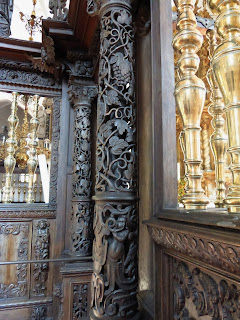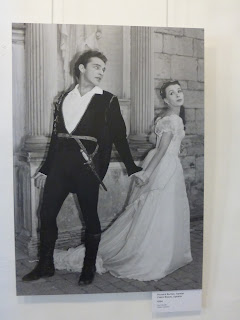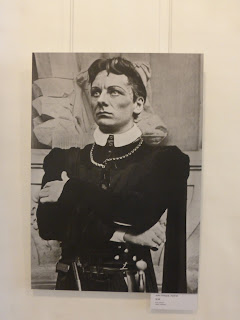I attended a viva voce
examination last week, in which the candidate stuck out his neck and suggested
that the anonymous author of The
Wonderful Discoverie of the Witchcrafts of Margaret and Phillip
Flower Daughters of Joan
Flower, by Beaver Castle, and executed at Lincolne the 11 of March 1618 had not
actually believed his own pamphlet’s
tale of deaths by witchcraft. His external examiner noted that the best guess
was that the writer was Samuel Fleming, D.D., a local J.P. and often named in
the text. Fleming would then have to have been a sceptic who concurred with the
fatal verdicts because, in the end, to quote the examiner herself, “a witch is
a person in front of a court accused of witchcraft”.
I had
missed any such subtleties in a pamphlet I’d read (after a fashion), so I decided
to take another look. The basic narrative is graspable enough: Joan Flower, and
her daughters Margaret and Philip (“The Charwoman, and her daughters Pocketing
and Filch”, as Richard Bernard quipped in 1626) were in service at Belvoir Castle,
Margaret actually living at the castle, until they were dismissed for
pilfering. In their revenge, a glove of young Henry Manners was stolen, rubbed
on the back of their cat familiar Rutterkin, then buried, causing the young
nobleman to waste away and die.
Fleming,
if it is him, starts off quite well. A reason for the veracity of witchcraft
lies in “those infinite Treatises of many of them convinced [‘convicted] by
Law, and condemned to death”. He has also had access to sceptical positions on
witchcraft: “there be certain men and women grown in years, and over-grown with
Melancholy and Atheism, who out of a malicious disposition against their
betters, or others thriving by them; but most times from a heart-burning desire
of revenge, having entertained some impression of displeasure, and unkindness,
study nothing but mischief and exotic practises of loathsome Arts and Sciences:
yet I must needs say, that sometimes the fained reputation of wisdom, cunning,
and to be reputed a dangerous and skilful person, hath so prevailed with
divers, that they have taken upon them indeed to know more then God ever afforded
any creature, & to perform no less then the Creator both of Heaven &
earth.” Age, craziness, malice, the desire in the self-fashioned witch to be
feared or respected; the impossibility of God allowing such powers to such
people - such points touch on good, solid objections to the veracity of
witchcraft and the eligibility of confession from such people.
Fleming
could supplement his treatise with other papers, examinations of further local
suspects: “These Examinations and some others were taken and charily preserved
for the contriving of sufficient evidences against them, and when the Judges of
Assise came down to Lincoln about the first week of March, being Sr. Henry
Hobert, Lord chief Justice of the Common Pleas, and Sr. Ed: Bromley one of the
Barons of the Exchequer.” The phrasing is unfortunate here, but the sense of ‘contriving’
was neutral.
So, ‘some’
of these ‘charily preserved’ papers he adds to his account in the most baffling
way: we have been reading about Joan Flower and her daughters, Margaret and
Philip. Suddenly, we have Anne Baker, Joane Willimot, and Ellen Greene brought
in as further suspects, with some of the evidence taken from them post-dating
the executions of Joan Flower’s daughters. Then Fleming lurches back in time to
provide examinations of Margaret and Philip Flower, taken in January and
February.
The
pamphlet says more than once that the accused women killed both of the children
of Francis Manners and his second wife Cecily. But the younger son did not die
until March 5th 1619-20:
If
March 1620 was the new style date of the younger boy’s death, we have a
pamphlet describing the convictions of the murderers on March 11th
1618 (if that’s an old style date, then we still have a year to close).
In 1688
‘R.B’ (Richard Bouvet) attempted to summarise the Belvoir Castle case in his
compilation of paraphrases, The kingdom
of darkness. R.B. cannot make sense of the chronology, so he falls back on
vagueness: “About the same time Joan Willimot of Goadby a Witch was examined by
Sir Henry Hastings and Dr. Fleming Justices in Leicestershire about the murder
of Henry Lord Ross…”
He
cannot work out why we are not told about the outcomes of the examinations of Anne
Baker, Joane Willimot, and Ellen Greene: “and the rest questionless suffered
according to their deserts.”
R.B.
does quote this passage from the 1618 pamphlet, a passage in which the young
Lord Francis Manners is still alive, though afflicted:
“At
last as malice increased in them so the Earls Family felt the smart of their
revenge, for Henry Lord Ross his eldest Son fell sick of a very unusual disease
and soon after died; His second Son the Lord Francis was likewise miserably
tortured by their wicked contrivances; And his Daughter the Lady Katherine was
oft in great danger of her life by their barbarous dealings, with strange Fits,
&c. the Honourable Parents bore all these afflictions with Christian
magnanimity.”
R.B. sensibly
leaves out all the inconsistent references in the 1618 pamphlet to the Earl
having lost more than one child to the diabolic conspirators:
“I have
presumed to present on the Stage of verity for the good of my Country & the
love of truth, the late woeful Tragedy of the destruction of the Right
Honourable the Earle of Rutlands Children …”
“the
Right Honorable Earl had sufficient grief for the loss of his Children; yet no
doubt it was the greater to consider the manner, and how it pleased God to
inflict on him such a fashion of visitation …”
“Notwithstanding
all this did the noble Earle attend his Majesty, both at New-market before
Christmas, and at Christmas at Whitehall; bearing the loss of his Children most
nobly, and little suspecting that they had miscarried by Witch-craft, or such
like inventions of the Divell …”
What
had been happening in Leicestershire? Tracy Borman was encouraged by the
opacities of the case to produce a conspiracy theory (the man who sought to
profit by the deaths of the boys was the Duke of Buckingham, set to marry
Katherine Manners as sole heir to her father’s fortune).
I haven’t
read Borman’s book, having been put off by that review. But there is undeniably a curious and unusual strand to the
witchcraft in the pamphlet, with the witches boasting that their practices will
prevent to the Earl and Countess having any more children: “She further saith,
that her Mother and she, and her Sister agreed together to bewitch the Earle and
his Lady, that they might have no more children.”
There
are certainly some things left unsaid in the text. Fleming ascribes to Francis
Manners, Lord Rutland, an exemplary
acceptance of God’s inscrutable will in allowing the innocent to be tormented.
Fleming is adopting the official (and rather comfortless) church line on
witchcraft: that you must accept your trials. The problem was that Manners and
his family were Catholics, so this exemplary Christian behaviour just has to be
treated as part of Manners’ general nobility of character.
But the
main unmentioned, un-located, and unidentified person has to be a Leicestershire
witchfinder. Who had pushed the 1616 case in Leicester, leading to the hanging
of nine women on the testimony of a demoniac boy? King James had disconcerted his
circuit judges by declaring that the case had been fraudulent. But a variant
upon the sentiment in The Late Lancashire
Witches ‘once and ever a witch, though knowest’ could be offered: ‘once and
ever a witchfinder, thou knowest’. The pleasure, at once sadistic and
righteous, of sending to the gallows those you have proved to be wicked seems
to have been irresistible to some. I think it might have been this same person
who is proving his point in the 1618 case. Someone had broadened the
investigations, drawing in Anne Baker, Joane Willimot, and Ellen Greene. They
seem to have been local wise women, whose general expertise was in pronouncing
whether a sick child had been ‘forespoken” or not.
Everybody
accused in this case is strikingly free with their confessions: “for here you
see the learned and religious Judges cried out with our Saviour, Ex ore tuo.” The triumphant allusion is to Luke 19, 22, ‘And
he saith unto him, Out of thine own mouth will I judge thee, thou wicked
servant.’ This aligns the court with one of Christ’s most harshly judgemental
moments, in the parable of the talents. They were also willing to name names: both
Willemot and Greene have been induced to say where they got their familiar
spirits from. “This Examinate [Willemot] saith, That she hath a Spirit which she
calleth Pretty, which was given unto her by William Berry of Langholme in
Rutlandshire, whom she served three years”… “She saith further, that Gamaliel Greete of
Waltham in the said County Shepheard, had a Spirit like a white Mouse put into
him in his swearing; and that if he did look upon any thing with an intent to
hurt, it should be hurt, and that he had a mark on his left arm, which was cut
away; and that her own spirit did tell her all this before it went from her.”
Ellen
Greene “saith, that one Joan Willimot of Goadby came about six years since to
her in the Wolds, and persuaded this Examinate to forsake God, and betake her
to the divel, and she would give her two spirits, to which she gave her
consent, and thereupon the said Joan Willimot called two spirits, one in the
likeness of a Kitlin, and the other of a Moldiwarp”. The author uses such
anecdotes and accusations to suggest a hinterland of cunning folk who have actually
bartered their souls to the devil: “They admit of those execrable conditions of
commutation of souls for the entertaining of the spirits, and so fall to their
abominable practises, continuing in the same till God laugh them to scorn.”
The
1618 pamphlet makes a passing reference to torture: “because the mind of man
may be carried away with many idle conjectures, either that women confessed
these things by extremity of torture”. Again, an off-note: torture of women,
minors in the view of the law, was not legally allowed. There’s something
collusive about ‘extremity of torture’, as though a little bit of torture was
only to be expected.
This pamphlet
was re-printed in 1621, perhaps as part of the backwash from the Elizabeth
Sawyer case, or maybe because the younger son had by then died. Whoever put
this reprint together added in an account of how to set about verifying
witchcraft by ‘swimming’ suspects. This notion came from other sources, but its
inclusion just might have been prompted by a rumour of such rough handling having
been used in Leicestershire, and used successfully.
Was
this Leicestershire witchfinder in fact Samuel Fleming himself? As a Doctor of
Divinity and a J.P., he had the right sort of credentials and position. He was
an eager reader of witchcraft tracts (his pamphlet begins with a commentary on
the books he approves, King James, John Cotta, Alexander Roberts and the rest;
he has examined sceptical positions).
His
fractured account of the Belvoir witches would then not be the product of a man
who didn’t believe what he was saying, but rather someone who believed it all
too well, masking his role, playing down the strength of his opinions. He evidently
regards young Francis Manners as doomed, dead already. He pushes Baker,
Willemot and Greene into the reader’s attention because they were products of his
newest investigations. If you look closely at the pamphlet, you see that Fleming
was working on Anne Baker on March 1st, 2nd and 3rd.
On the first day, in front of Francis Manners, his brother George, and Fleming,
Baker resisted quite successfully. She then had a day being interrogated by Fleming
alone, and he established a connection to the main inquiry when she repeated (or
was lead to repeat) the story of the buried glove. By the third day, back in
front of George Manners and Fleming, she confessed to having a familiar spirit in
the form of a white dog: far better for a conviction than her previous baffling
talk of their being four colours of planets that can strike people.
In demonological
theory, the deaths of Joan, Margaret and Philip Flower should have seen young
Francis Manners recover quickly. Francis Manners, Lord Rutland, had showed
little appetite for the investigation of witchcraft, but he obviously believed
in it: his own memorial records the death of both of his sons as a result of witchcraft. There might have been
some pressure to find other suspects when young Manners did not recover after
March 11th, the date of the executions.
To
conclude, there is a sense of the stories not
being told in this pamphlet. Leicestershire was not at this time an area liable to foster disbelief. Samuel Fleming, D.D. and J.P. might have been a covert sceptic. But
he might instead have been a covert witchfinder. 'Utinam tam facile vera invenire possem, quam falsa convincere', ends the pamphlet, Cicero's 'Would that I could find the true as easily as I can detect the false'.
An enigma!








































